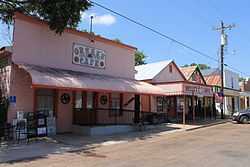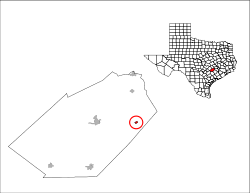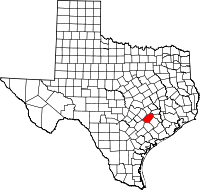Fayetteville, Texas
| Fayetteville, Texas | |
|---|---|
| City | |
 | |
|
Location of Fayetteville in Texas | |
 | |
| Coordinates: 29°54′18″N 96°40′30″W / 29.90500°N 96.67500°WCoordinates: 29°54′18″N 96°40′30″W / 29.90500°N 96.67500°W | |
| Country | United States |
| State | Texas |
| County | Fayette |
| Area | |
| • Total | 0.4 sq mi (1.1 km2) |
| • Land | 0.4 sq mi (1.1 km2) |
| • Water | 0.0 sq mi (0.0 km2) |
| Elevation | 394 ft (120 m) |
| Population (2000) | |
| • Total | 258 |
| • Density | 602.4/sq mi (232.6/km2) |
| Time zone | Central (CST) (UTC-6) |
| • Summer (DST) | CDT (UTC-5) |
| ZIP code | 78940 |
| Area code(s) | 979 |
| FIPS code | 48-25644[1] |
| GNIS feature ID | 1357269[2] |
Fayetteville is a city in Fayette County, Texas, roughly halfway between Austin and Houston. The population was 274 at the 2010 census.
The town is about twelve miles east of La Grange and U.S. Highway 77; it is about twelve miles north of Borden and Interstate 10.
History
Fayetteville's first immigrant settlers were the families headed by John Crier, James Cummins, and James J. Ross three of the Old Three Hundred. The settlement began at the location of a stagecoach stop on an old road between San Felipe and Bastrop.
Even though Fayette County was named after General Lafayette, a Revolutionary War hero (initially Marquis de Lafayette until June 1790, when he permanently renounced both the nobility and aristocratic titles"[3]), however, the community become Fayetteville in honor of someone else. According to the Handbook of Texas, in 1844 the community was named after the North Carolina birthplace of a prominent citizen of the time, who had surveyed the community, named its streets, and donated lots for the Fayetteville Academy and the town's multidenominational Union Church.
Fayetteville was incorporated in 1882.

The town made national news during World War I. As reprinted by Stars and Stripes in its March 15, 1918 issue, the town's mayor, W. C. Langlotz, and ten of the town's citizens were charged with espionage. They were arrested following the display of the flag of the German Empire over the entry of the Germania club in Fayetteville. The group pleaded "not guilty": the mayor said the flag had been displayed by mistake.
Geography
Fayetteville is located at 29°54′18″N 96°40′30″W / 29.904922°N 96.675119°W (29.904922, -96.675119).[4]
According to the United States Census Bureau, the town has a total area of 0.4 square miles (1.0 km2), none of which is covered with water.
Demographics
As of the census[1] of 2000, there were 261 people, 120 households, and 71 families residing in the city. The population density was 602.4 people per square mile (234.4/km2). There were 183 housing units at an average density of 422.4/sq mi (164.3/km2). The racial makeup of the city was 96.55% White, 3.07% African American, and 0.38% Asian. Hispanic or Latino of any race were 1.53% of the population.
There were 120 households out of which 20.8% had children under the age of 18 living with them, 48.3% were married couples living together, 10.8% had a female householder with no husband present, and 40.8% were non-families. 35.8% of all households were made up of individuals and 24.2% had someone living alone who was 65 years of age or older. The average household size was 2.17 and the average family size was 2.89.
In the city the population was spread out with 19.5% under the age of 18, 7.7% from 18 to 24, 20.7% from 25 to 44, 24.5% from 45 to 64, and 27.6% who were 65 years of age or older. The median age was 46 years. For every 100 females there were 74.0 males. For every 100 females age 18 and over, there were 72.1 males.
The median income for a household in the city was $27,639, and the median income for a family was $31,667. Males had a median income of $26,250 versus $18,125 for females. The per capita income for the city was $13,916. About 8.0% of families and 13.2% of the population were below the poverty line, including 37.5% of those under the age of eighteen and 12.7% of those sixty five or over.
Education
The City of Fayetteville is served by the Fayetteville Independent School District.
References
- ↑ 1.0 1.1 "American FactFinder". United States Census Bureau. Retrieved 2008-01-31.
- ↑ "US Board on Geographic Names". United States Geological Survey. 2007-10-25. Retrieved 2008-01-31.
- ↑ Niles' Weekly Register, BALTIMORE, June 26, 1824; LAFAYETTE
(before Lafayette’s arrival in NYC on August 15, 1824; In an 1818, book preface to Olive Branch, Lafayette’s close friend and protégé, Mathew Carey wrote of Nile's, "the best periodical work ever published in America")
"I have taken the liberty to strike out "the marquis" and say "general" LaFayette: seeing that he himself has disavowed the title, it is to be hoped the republicans of the United States will not offend him by heaping the senseless thing upon him" - ↑ "US Gazetteer files: 2010, 2000, and 1990". United States Census Bureau. 2011-02-12. Retrieved 2011-04-23.
External links
- Fayetteville from the Handbook of Texas Online
- Day trip to Fayetteville, from the February 25, 2000 issue of the Austin Chronicle
| |||||||||||||||||||||||||
